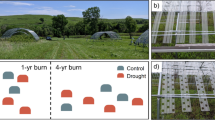Abstract
This paper presents selected results on the above- and below-ground growth performance of twelve indigenous woody species commonly found growing naturally in unstable riparian slope and/or bank environments throughout New Zealand. This study was needed because little information exists on the effectiveness of New Zealand’s indigenous riparian plant species for slope and stream bank stabilisation. By examining the growth performance of selected riparian species during the first 5 years following establishment, we provide valuable insights into the likely strengths and limitations of individual species at maturity and, therefore, into their overall potential usefulness, singularly and/or as mixed plantings, for future riparian stabilisation projects. For all species, their root systems are typically shallow and confined to the uppermost 31 cm of soil. Root spread (mean maximum diameter) increased with increasing age with interspecies differences, by age 5 years, ranging from between ~1 and 2.5 m. At age 5 years the mean root biomass, for all species combined, was 1.2 kg/plant, and averaged ~23% of total plant biomass. Changes in the allocation of biomass for root and shoot growth appear to be species and age dependent. The results of this study indicate that most have above- and below-ground growth attributes well suited to colonising steep and unstable riparian slopes where shallow soil failure is prevalent and/or where stream banks are rocky with skeletal soils. All form part of the early plant succession. Once established, and in the absence of grazing, they are relatively fast growing. The effectiveness of riparian restoration programmes using indigenous species, though potentially high for low-order stream, will be limited by their relatively shallow-rooted habit for bank stabilisation on larger rivers without the prior installation of structural protection works.
Similar content being viewed by others
References
B Abernethy I D Rutherfurd (2001) ArticleTitleThe distribution and strength of riparian tree roots in relation to riverbank reinforcement Hydrol. Process. 15 63–79 Occurrence Handle10.1002/hyp.152
A R Acheson (1968) River control and drainage in New Zealand Ministry of Works New Zealand 296
Allan Herbarium 2000 New Zealand Plant Names Database, Landcare Research, New Zealand. Available http://nzflora.landcareresearch.co.nz (Accessed 22 November 2004).
R J Cameron (1963) ArticleTitleA study of the rooting habits of rimu and tawa in pumice soils N. Z. J. For. 8 771–785
Cowley J M and Whyte C F 1997 Impact assessment for sawfly on Willow, Nematus oligospilus Förster (Hymenoptera: Tenthredinidae). New Zealand Plant Protection Centre, Lynfield, Auckland. Internal Ministry of Agriculture Report. 20 pp.
A Czernin ( 2002 ) Above-ground and below-ground characteristics of the New Zealand cabbage tree (Cordyline australis) with particular reference to the root system morphology and root strength. MSc thesis University of Agricultural Sciences Vienna 183
G Easson L D Yarbrough (2002) ArticleTitleThe effects of riparian vegetation on bank stability Environ. Eng. Geosci. 8 247–260
G O Eyles (1983) ArticleTitleThe distribution and severity of present soil erosion in New Zealand N. Z. Geog. 39 12–28
Foweraker C E, 1929 The podocarp rain forests of Westland, New Zealand. Kahikatea and Totara forests, and their relationships to silting. Te Kura Ngahere. A forestry journal issued by the Forestry Club of the Canterbury College School, Christchurch, New Zealand.
A E Hewitt (1998 ) New Zealand Soil Classification EditionNumber2 SeriesTitleLandcare Research Science Series No. 1 Manaaki Whenua Press Lincoln, New Zealand
IPCC, 2000: Land Use, Land-Use Change, and Forestry. A Special report of the IPCC [Watson R T, I R Noble B Bolin N H Ravindranth D J Verardo and D J Dokken, (Eds.)]. Cambridge University Press, Cambridge, UK.
Marden M and Phillips C J 2002 How do native riparian plants grow? Conservation Quorum, 14--15.
Marden M and Phillips C J 2003 Stream bank planting trials. Conservation Quorum, 12--13.
Marden M and Phillips C J 2004 Stream bank planting trialsthe final chapter. Conservation Quorum, 7--8.
New Zealand Climate Change Office 2003 Climate change. National Inventory Report for New Zealand. Greenhouse Gas Inventory, 1990–2001. Ministry for the Environment, Wellington. 86 pp.
C J Phillips A J Watson (1994) Structural tree root research in New Zealand, a review. Landcare Research Science Series 7 Manaaki Whenua Press Lincoln
Phillips C J, Marden M, Rowan D and Ekanayake J C 2001 Stabilising characteristics of native riparian vegetation in New Zealand. In Proc. 3rd Australian Stream Management Conference, Brisbane August 2001, 507–512.
H M Schiechtl R Stern (1994) Handbuch für naturnahen Wasserbau, Eine Anleitung für ingenieurbiologische Bauweisen Österreichischer Agrarverlag Wien
Kraayenoord C W S Van and Hathaway R L 1986 Plant materials handbook for soil: conservation, Vol. 2, Introduced Plants. 229.
A J Watson C L O’Loughlin (1985) ArticleTitleMorphology, strength, and biomass of manuka roots and their influence on slope stability N Z J. For. Sci. 15 337–348
A J Watson C L O’Loughlin (1990) ArticleTitleStructural root morphology and biomass of three age classes of Pinus radiata N Z J. For. Sci. 20 97–110
A J Watson M Marden D Rowan (1995) Tree species performance and slope stability D H Barker (Eds) Vegetation and Slopes Thomas Telford Press London 161–171
A J Watson C J Phillips M Marden (1999) ArticleTitleRoot strength, growth, and rates of decay: root reinforcement changes of two tree species and their contribution to slope stability Plant Soil 217 39–47 Occurrence Handle10.1023/A:1004682509514
Author information
Authors and Affiliations
Corresponding author
Rights and permissions
About this article
Cite this article
Marden, M., Rowan, D. & Phillips, C. Stabilising Characteristics of New Zealand Indigenous Riparian Colonising Plants. Plant Soil 278, 95–105 (2005). https://doi.org/10.1007/s11104-004-7598-2
Received:
Accepted:
Issue Date:
DOI: https://doi.org/10.1007/s11104-004-7598-2




